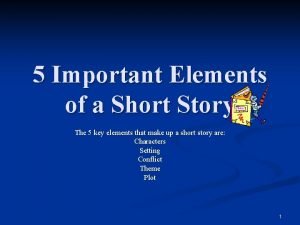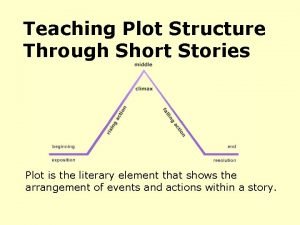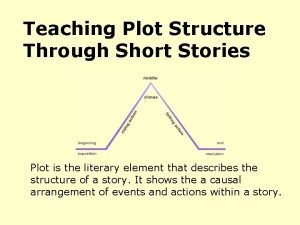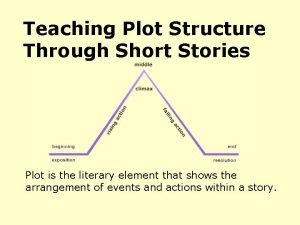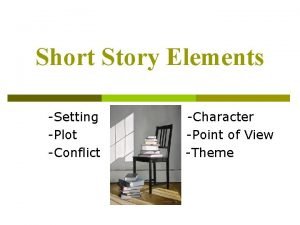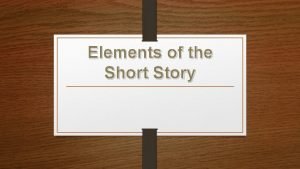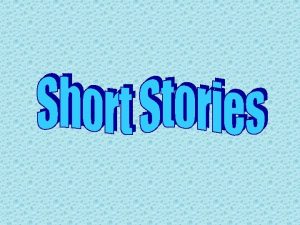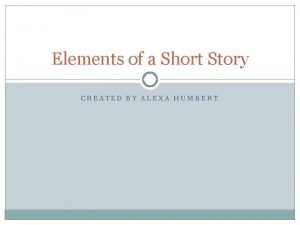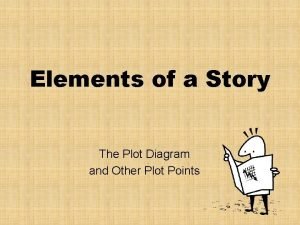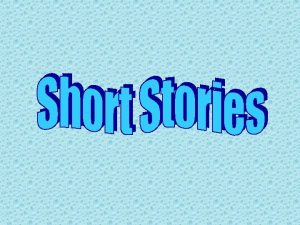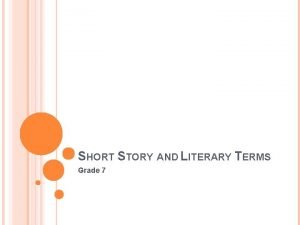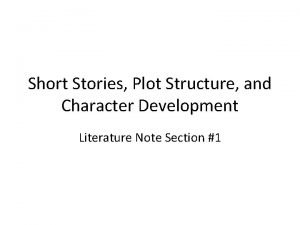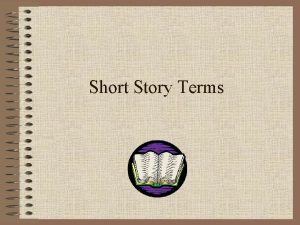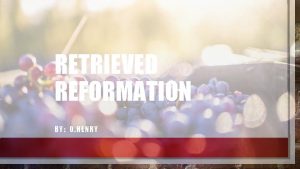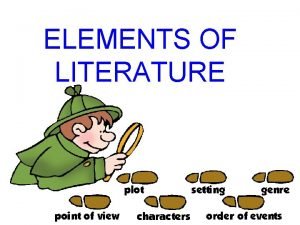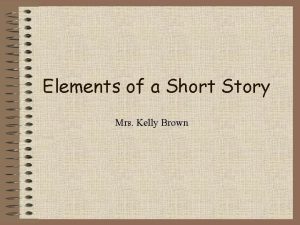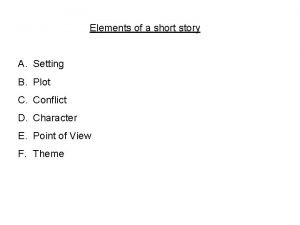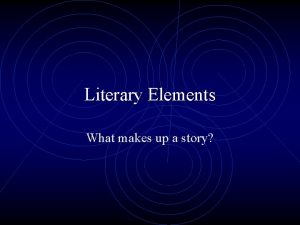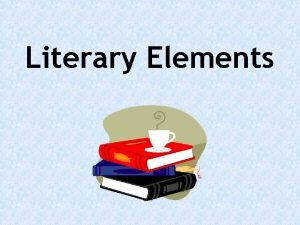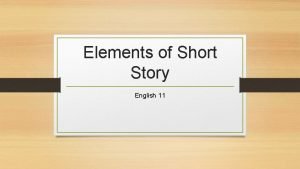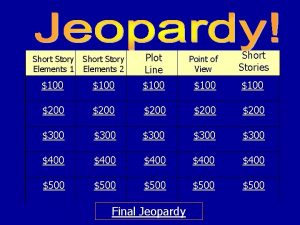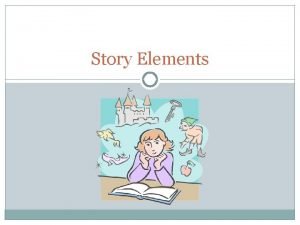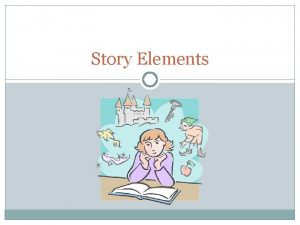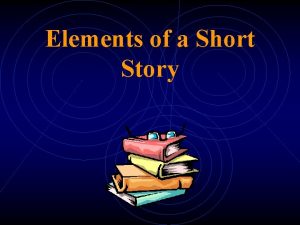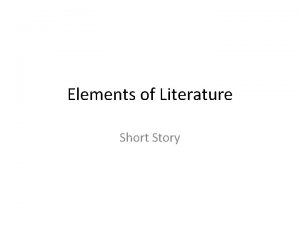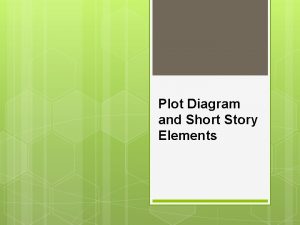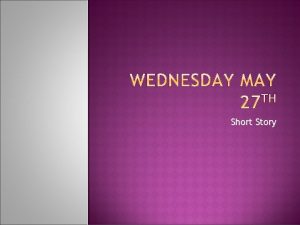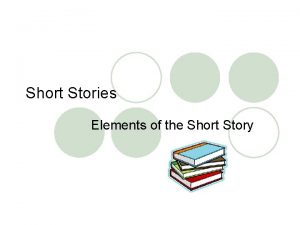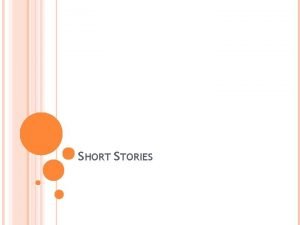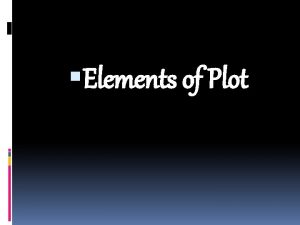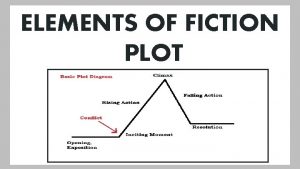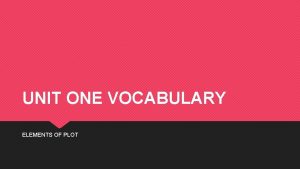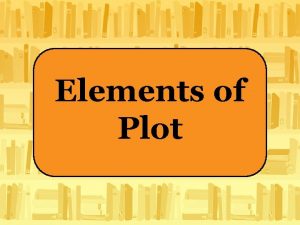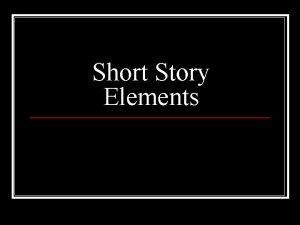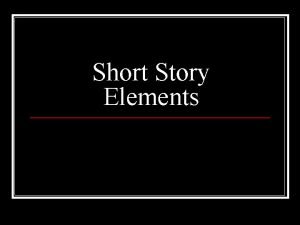ELEMENTS OF THE SHORT STORY PLOT PLOT STORY
























- Slides: 24

ELEMENTS OF THE SHORT STORY

PLOT

PLOT & STORY ANALYSIS Not every story unfolds the same way, but the basic plot structure (5 parts of plot) is as follows: � Exposition (Introduction) – introduces the setting and characters and establishes a mood. It may also reveal the conflict or set the stage for it � Rising Action – complications arise as the main character struggles to resolve the conflict � Climax – this is the turning point in the story…the moment of greatest suspense. Often the main character makes a decision or takes an action that makes the outcome of the conflict clear � Falling Action – this stage shows the results of the decision or action that happened at the climax. Tensions ease � Resolution – reveals the final outcome of the story and ties up any loose ends

POINT OF VIEW The angle or perspective from which the story is told Who is telling the story? �For instance, is it a player on the home team or someone watching the game? How do we know what is happening? �For instance, does a character tell us?

FIRST PERSON POV Told from the viewpoint of one of the characters, using the first person pronoun “I”. “The thousands of injuries of Fortunato I had borne as I best could, but when he ventured upon insult I vowed revenge. You, who so well know the nature of my soul, will not suppose, however, that I give utterance to a threat. ” “The Cask of Amontillado” by Edgar Allan Poe

Innocent Eye: The story is told through the eyes of a child (his/her judgment being different from that of an adult). Stream of Consciousness: The story is told so that the reader feels as if they are inside the head of one character and knows all their thoughts and reactions.

SECOND PERSON POV The main character in the story is referred to using the second person pronoun “you” “Rubbing your aching head, you take in the scene around you. Nearby you see a narrow dirt road, and beyond it a fastrunning brook. The road disappears into dense woods on either side of the field. You hear the sound of hooves, and a strange clanking noise. Someone is coming! You duck behind a tree as two men on horseback ride toward you. They are wearing shining metal armor. One of them carries a white banner with a golden lion on it. They must be knights! You watch as they rein in their horses and dismount just a few yards away. ” Choose Your Own Adventure : The Forbidden Castle by Edward Packard

THIRD PERSON POV The story is told using a narrator who is located outside of the action of the story and uses third person pronouns such as “he”, “she”, “his”, “her”, “they” etc. Third Person Point of View can be broken up into three different types: Omniscient Limited Omniscient Objective

OMNISCIENT POV The narrator has the power to show the reader what is happening though a number of characters’ eyes. “Myop carried a short knobby stick. She struck out at random at chickens she liked, and worked out the beat of a song on the fence around the pigpen. She felt light and good in the warm sun. She was ten, and nothing existed for her but her son, the stick she clutched in her dark brown hand, and the tat-de-ta-ta-ta of accompaniment. ” “The Flowers” by Alice Walker

LIMITED OMNISCIENT POV Third person, told from the viewpoint of a character in the story. “They all laughed, and while they were laughing, the quiet boy moved his bare foot on the sidewalk and merely touched, brushed against a number of red ants that were scurrying about on the sidewalk. Secretly his eyes shining, while his parents chatted with the old man, he saw the ants hesitate, quiver, and lie still on the cement. He sensed they were cold now. ” “Fever Dream” by Ray Bradbury

OBJECTIVE POV Third person, told as if from a camera that follows the characters. Only what is said and done is recorded. “Jennifer stirred in bed. The cotton sheet clung to her body as she rolled to face the nightstand. With eyes half open, she reached over to switch the alarm clock off when the man in the shadows reached out and grabbed her arm. Her scream pierced the quiet night and died abruptly as she was forced violently back into the dark oblivion. ” “Objective Point of View” writesville. com

SETTING, MOOD, PLOT SETTING - The time and place of a story – includes the following: � The For example: London, Cairo, Halifax, Vancouver � The geographical location time period For example: 1865, during WWII, today � The socio-economic characteristics of the location For example: wealthy suburbs � The specific building, room etc. For example: a prep school, a log cabin, a bus, a military base

MOOD – The feeling or atmosphere that a writer creates for readers �Ominous, uplifting, scary, suspenseful, etc. • What kinds of stories or movies have you read where the setting was crucial to the story’s overall meaning • How can the mood of a story change suddenly? How do you know…what elements in the story are clues to the change?

TIPS & WARNINGS It’s not always easy to find the tone of a piece of writing. Many authors will use a neutral tone if they are writing about factual events Others will use the language to show their opinion on the topic Be careful to separate mood from tone. The tone shows you an author’s opinion, while mood is the feeling and atmosphere of the text

CHARACTERIZATION Round characters (Dynamic): � � � Complex Have many traits Have a range of emotions Have strengths and weaknesses Change over the course of the story (this is the Dynamic part) Their role is to serve as main characters who make a story rich and interesting and help define theme Flat characters (Flat): Possess only 1 or 2 traits � Show few emotions � May be stereotypes � Don’t grow or change (this is the Flat part) � Their role is to serve as minor characters who advance the plot or provide information/ to reveal something about the main characters LET’S READ THE EXAMPLE ON PAGE 161 IN YOUR BOOKS �

INFERENCES On standardized tests with a verbal, reading comprehension or critical reading section, you're going to have to make an inference at some point. An inference is an assumption made based on specific evidence. Someone might say to you, "Nice hair, " and you make the inference that the person is being rude and is really insulting you because it was said with a smirk. You infer the implied meaning – the meaning not said directly. Inferences are made by doctors when they diagnose conditions, by FBI agents when they follow clues, by mechanics when they figure out what's wrong with your car.

LET’S PRACTICE MAKING INFERENCES 1. I wouldn't eat after that two-year-old if I were you. Inference: The two-year-old probably did something gross to the food you were about to eat or has a cold and you could catch it. Something bad will happen to you if you eat it! 2. For Valentine’s Day, my fantastic neighbor gave his wife a poem that took him about two seconds to write. Sheesh. 3. Inference: My neighbor is not very considerate since he didn't take his time writing the poem. 4. As you give a speech in front of a large audience, you realize that people are laughing behind their hands and pointing to the region below your waist. Inference: 5. A woman walks into a hospital clutching her abdomen and cursing out her husband, who trails behind her carrying a large bag. Inference:

CONFLICTS Man v Nature – A run-in with forces of nature. “To Build a Fire” by Jack London Man v Society - The values and customs by which everyone else lives are being challenged. Wuthering Heights Man v Self – Internal conflict…sometimes people are their own worst enemies. A Beautiful Mind Man v Machine - Places a character against robotic forces with Artificial Intelligence. I, Robot and the Terminator series are good examples of this. Man v Man – Conflict that pits one person against another. Examples? ?

THEME Theme is the central idea or central message of the story. It usually contains some insight into the human condition – telling something about humans and life. The theme can be stated directly or implied by the events and actions in the story.

TYPES OF IRONY Verbal Irony: This is the contrast between what is said and what is meant. In other words: sarcasm. Dramatic Irony: This is the contrast between what the character thinks to be true and what we (the reader) know to be true. Sometimes as we read we are placed in the position of knowing more than what one character knows. Because we know something the character does not, we read to discover how the character will react when he or she learns the truth of the situation. Situational Irony: This is the most common in literature. It is the contrast between what happens and what was expected (or what would seem appropriate). Because it emerges from the events and circumstances of a story it is often more subtle and effective than verbal or dramatic irony. Irony – the contrast between what is expected or what appears to be and what actually is

SYMBOLISM A SYMBOL REPRESENTS AN IDEA, QUALITY, OR CONCEPT LARGER THAN ITSELF A journey can symbolize life A lion can be a symbol of courage Other examples? Water may represent cleanliness A red rose can represent love and renewal

FLASHBACK This is a writers’ technique in which the author interrupts the plot of the story to recreate an incident of an earlier time (goes back in time; like giving the reader a memory). This device is often used to provide additional information to the reader

TIME TO THINK… “We hold these truths to be self-evident that all men are created equal…” (Declaration of Independence) Are people truly created equal?

TIME TO THINK… With two other people, brainstorm possible advantages and disadvantages of a world where everyone is the same – exactly average.
 Tall + short h
Tall + short h Key elements of a short story
Key elements of a short story What is short story
What is short story Shrek falling action
Shrek falling action Story plot structure
Story plot structure What is a plot in a story
What is a plot in a story Short story english with setting characters and plot
Short story english with setting characters and plot Plot diagram explanation
Plot diagram explanation Plot setting characters
Plot setting characters Encyclopedia britannica
Encyclopedia britannica Parallel plot short story examples
Parallel plot short story examples Falling action
Falling action Short story with characters, setting, and plot
Short story with characters, setting, and plot Short story plot structure
Short story plot structure Setting in literature
Setting in literature My favorite chaperone character analysis
My favorite chaperone character analysis Why does molly maguire ask for a fur coat
Why does molly maguire ask for a fur coat Symbol in a short story
Symbol in a short story Plot diagram example
Plot diagram example Different elements of literature
Different elements of literature Story definition
Story definition Setting of a story
Setting of a story Elements of a short story video
Elements of a short story video Elements of the story cinderella
Elements of the story cinderella Five elements of
Five elements of

